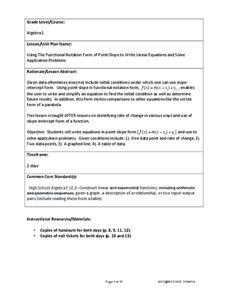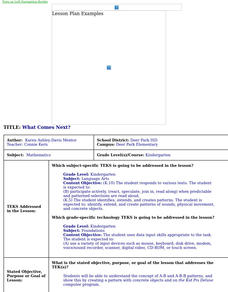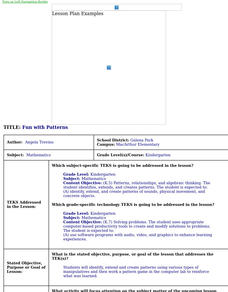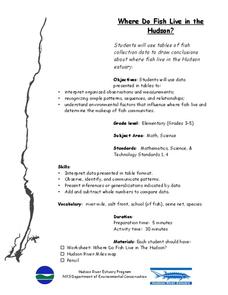Curated OER
Fantastic Fraction Fudge
In order to create some tasty fudge, learners must adapt a recipe. Using a recipe for fudge, ingredients must be correctly converted using fractions. If one fraction is incorrect, the fudge will reveal it! Although you will only make one...
Curated OER
Tennis Ball Tubes
Learners determine whether the height of a tennis ball tube or the distance around the tube is greater, or whether they are the same. Using the formula for the circumference and diameter of a sphere, they discuss the word problem, and in...
Curated OER
Discovering New Units
Young scholars use Cuisenaire rods to explore common denominators. In this fractions lesson, students build Cuisenaire representations of fractions, then find their equivalent counterparts to find the common denominator.
Curated OER
Transformations in the Coordinate Plane
Your learners connect the new concepts of transformations in the coordinate plane to their previous knowledge using the solid vocabulary development in this unit. Like a foreign language, mathematics has its own set of vocabulary terms...
West Contra Costa Unified School District
Point-Slope Application Problems
Create a linear equation for a problem when the intercept information is not given. The two-day lesson introduces the class to the point-slope form, which can be used for problems when the initial conditions are not provided. Pupils...
02 x 02 Worksheets
Factoring
Factor in this resource when teaching how to factor polynomials. Scholars use algebra tiles to factor linear and quadratic expressions. They practice their skill by working on example problems from a worksheet.
Curated OER
Froggy Fun
Students use downloadable pages to sort the stages of the frog life cycle into the correct, labelled sequence.
Curated OER
Home Living/Life Skills: Face Washing
Having good hygiene skills is a very important part of living an independent life. Learners with special needs follow sequencing cards to practice washing their faces. They follow each step in the process and discuss the importance of...
Curated OER
Pebbles, Sand and Silt -- Categorizing Fiction and Informational Books
Primary readers complete the activities in a Pebbles, Sand and Silt FOSS kit. As a class, they are given a group of rocks and they are to categorize them based on their activities in the FOSS kit. They use this information and apply it...
Curated OER
Lines of Symmetry
Young scholars practice dance to divide the space or body shape into equal sections to create symmetry in dance. In this symmetry lesson, students practice symmetrical and asymmetrical movements in dance. Young scholars participate in...
Curated OER
Children's Literature Across the Curriculum Ideas-Lincoln: A Photobiography
Students read Lincoln: A Photobiography by Russell Freedman. They complete a variety of cross-curricular activities surrounding the life of Abraham Lincoln, including, but not limited to, the Civil War. Included are reading, art, math,...
NSW Department of Education
Relationships Between Formal Measurement Units: Measure and Record Mass in Kilograms and Grams
Teach the masses about the metric system with this hands-on measurement lesson. Given a fruit or vegetable, learners estimate, measure, and convert its mass using the metric units gram and kilogram.
Curated OER
Fibonacci Numbers
Students calculate the Fibonacci sequence of numbers. Through the use of Fibonacci numbers in flowers, leaves, fruits, vegetables, pine cones, and other forms of nature; students explore how Fibonacci numbers occur in nature. Then they...
Curated OER
What Comes Next?
Students explore the concept of A-B and A-B-B patterns, and show this by creating a pattern with concrete objects and on the Kid Pix Deluxe computer program.
Curated OER
Working Backwards
Sixth graders make up their own math problems. There is only one restriction. That is, the answer has to be the one you are going to give them in a sealed envelope. The problems that they make up can be anything they like. Let Students...
Curated OER
Fun with Patterns
Students identify, extend and create patterns using various types of manipulatives and then work a pattern game in the computer lab to reinforce what was learned.
Curated OER
Treasure to Ship
Second graders explore and solve an algebraic word problem. They listen to a poem about pirates, describe the word problem in their own words, and independently solve the problem using colored rods to represent the pirates and treasure...
Curated OER
In Your Prime
Students study how to find prime numbers. They investigate the teachings of the mathematician Eratosthenes and apply his theory of prime numbers less than 100.
Curated OER
Rolling Marbles
Pupils develop and use problem solving strategies to mathematically solve a word problem involving marbles. They solve the first part of the problem together as a class, and in small groups solve and write a solution for the problem...
Curated OER
Number Stories
Pupils write and solve various number stories. They solve number stories using one, two and three digit numbers. Students practice writing sentences using the following 6+1 traits, ideas and content, organization, word choice and...
Curated OER
Where Do Fish Live in the Hudson?
Learners explore the environmental factors that influence where fish live and determine the makeup of fish communities in the Hudson. They interpret guided observations and measurements to assess patterns, sequences and relationships.
Curated OER
Handshakin'
Students investigate the concept of solving problems when given it in words and employing a wide variety of methods. They practice applying a logical sequence to find the solution to a problem while estimating possible answers to help in...
Curated OER
Sum of Infinite Geometric Series
Your mathematicians solve problems using geometric series in this pre-calculus lesson. They divide a unit square into very small pieces and identify the reasoning behind the sum of a series being less than one.
Curated OER
Taylor Polynomials
Pupils graph Taylor polynomials in this calculus instructional activity. They observe the graphs for the expansion of Taylor polynomial functions and use the Ti calculator to help create visuals of the graphs.

























